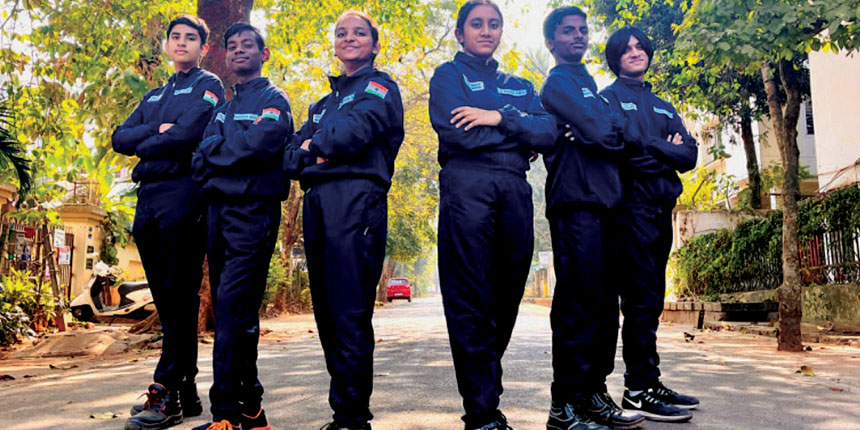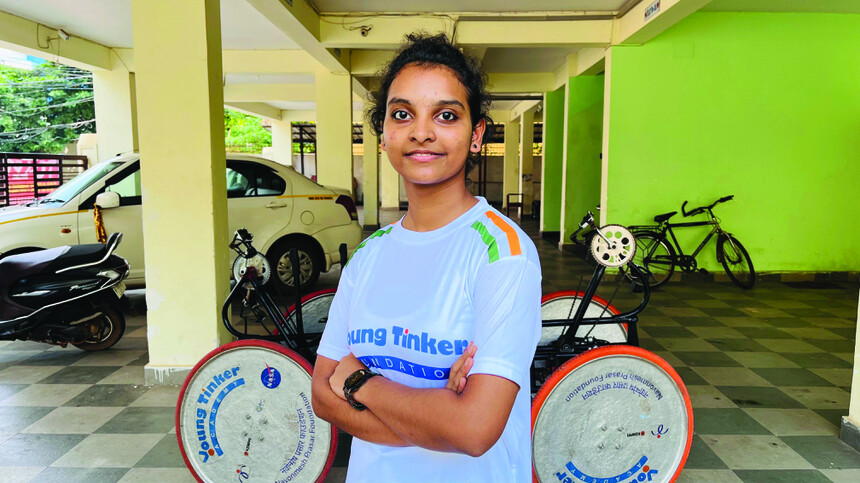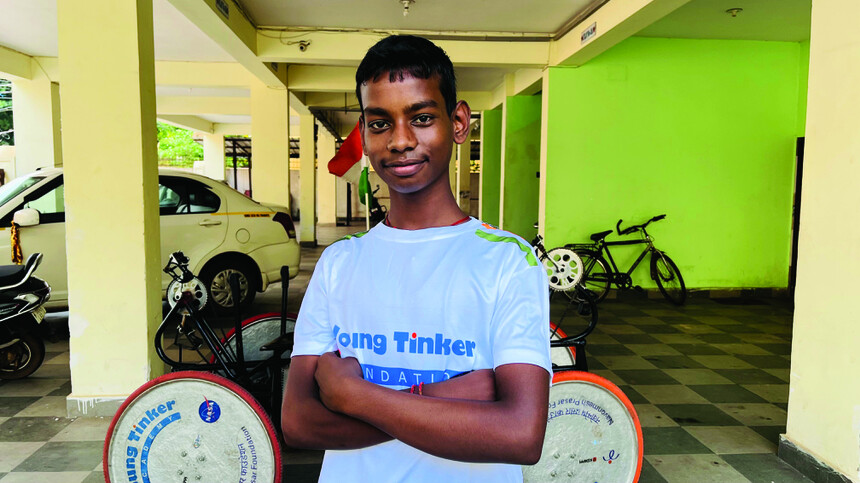NASA Rover Challenge: Orphans, children of daily-wagers build land rover for the moon
R. Radhika | March 2, 2023 | 01:58 PM IST | 7 mins read
NASA Human Exploration Rover Challenge: A daily-wager’s son was prototype lead; an orphan led branding, communication.
CBSE 12 Class Free Mock Test
Boost your exam preparation with our CBSE 12 Class Free Mock Test, designed as per the latest exam pattern.
Attempt Now
NEW DELHI: Basudeba Bhoi balances everyday school work with building a human exploration rover capable of traversing on the rocky and dusty terrain of the moon. Bhoi, 14, is from Baral village of 42 Mouza in Cuttack, Odisha, where his parents are daily-wage farm labourers.
New: CBSE 2026 Final Date Sheet PDF Released - Download Here
Latest: Free All-India JEE Main 2026 Mock Test - Attempt Now
CBSE Class 12: Free Mock Test | Formula Sheet: Maths | Physics | Chemistry
CBSE Class 12 (All Subjects): PYQ's | Question Bank | Practice Questions | Sample Papers
After teaching himself 3D printing technology and innovating a bionic hand with open-source material, Bhoi is now working on his next passion – space exploration.
He and six other school students are building a rover for the National Aeronautics and Space Administration’s (NASA) annual Human Exploration Rover Challenge (HERC) 2023. Bhoi’s team is part of a non-profit called Young Tinker Educational Foundation that educates school children about STEAM (science, technology, engineering, arts and mathematics) disciplines. All members have been part of the foundation’s sundry tinkering programmes.
“As a kid, I was always interested in astronomy and science fiction and the idea of discovering new worlds and space exploration really appealed to me. When I came to know about HERC 2021, I started researching the rover challenge. Now that our team has been selected, I will work hard and give my 100 percent effort in the challenge,” said Bhoi.
The NASA HERC 2023 features a global engineering design challenge every year for school and college students. The event – “a more complex follow-up to the successful NASA’s Great Moonbuggy Race,” says American Institute of Aeronautics and Astronautics– aligns with NASA’s mission to explore the lunar surface with the help of a roving vehicle.
Also Read| India’s new IAU astronomy centre will assess quality of astronomy education in schools
The team sent a proposal to NASA HERC and was shortlisted to participate in October last year. Since then, the team has been designing, testing materials, and manufacturing a “human-powered rover vehicle” that can function on extra-terrestrial terrain. The team is one of 61 teams from 30 countries that will travel to Alabama, US in April. The rover will be shipped to NASA’s Marshall Space Flight Center first.
NASA rover team
Anil Pradhan, 26 and the founder of the Young Tinker Educational Foundation, assembled an extremely diverse set of students to form the team. “Apart from the age criterion, we do not look for any minimum qualification while selecting, rather their skills and the drive to do something significant. None of them knew how to build a rover so we focused on their intent to make one,” said Pradhan.
Growing up in Adruta Children’s Home, an orphanage in Odisha, Akankshya Dash (17) had limited means of realising her dream of studying engineering in the US. But her curiosity, she said, earned her a spot on the team.
 Akankshya Dash is the communication lead in Young Tinker team.
Akankshya Dash is the communication lead in Young Tinker team.
“I was four when my father passed away and my mother was unable to take care of me. She left me in an orphanage. The people at the orphanage helped nurture my talents. They always tried to provide for me, whether it was my education or my interest in science. They came to know about the NASA project and took me to meet Anil sir. I gave an interview and was selected.”
Apart from Bhoi and Dash, the team includes16-year-old Om Padhi, another resident of Adruta Children Home. Class 12 students, Siddhanth Ghosh (18) from Maharashtra and Sai Akshara Vemuri (17) from Andhra Pradesh; and Class 10 student Chittineni Akarsh (15), also from AP, are the other members.
Each member has been assigned a role like prototype lead, marketing and branding lead, technical lead, design lead and so on. While someone worked on the chassis, some perfected the breaks, another worked on the wheels or ergonomics.
 Basudeba Bhoi is a prototype lead in the Young Tinker's NASA Rover Challenge 2023 team
Basudeba Bhoi is a prototype lead in the Young Tinker's NASA Rover Challenge 2023 team
“As prototype lead, my role is to manage the development of a prototype application or system. This includes designing, developing, and testing the prototype prior to its launch. My responsibilities include designing the overall system architecture, selecting the appropriate development platform, developing the user interface and associated logic, testing the application prior to launch, and leading the team through the design and development process. Additionally, I am responsible for ensuring that all technical requirements are met and that the prototype is built in time,” said Bhoi.
Dash, who had no relevant skills for building a rover, worked on the branding and marketing strategies.
“I work as a communication lead. I am responsible for marketing and branding of our product. I also lead seminars that we conduct in various schools related to STEM education and hold workshops to make students aware about the disciplines. So far, I have been to several government schools, public ITIs and English-medium private schools to conduct such seminars. Apart from working on the rover, I was trained in interacting with other children and representing the team and its work,” said Dash.
However, this is not the first time Pradhan has mentored a team for NASA’s rover challenge. In 2021, amid the pandemic, Pradhan built a team of children from financially disadvantaged backgrounds.
“Kailash Barik, a cycle mechanic from Mayurbhanj was our prototype lead, and Rina Bagha, working in a welding shop and the sole breadwinner of the family, was a part of our team. Both were out of school. With them we made a team of 10 students who went on to win the third position in the rover challenge. In a competition where mostly US students dominate, our team was Asia’s first to bag a winning spot,” The win and coverage in local media helped the organisation grow. Schools were eager to start “tinker spaces”. “We are also taking our Young Tinkering spaces to the US,” said Pradhan with pride.
NASA challenge
The competition requires students to design vehicles to traverse about a half-mile course that includes a simulated field of asteroid debris, boulders, erosion ruts, crevasses, and an ancient streambed. For high performance with greater efficiency, the challenge is to meet the weight and time requirements and build a compact rover.
“There is a computer-assisted design programme called SOLIDWORKS where I take all the designs and render them in 3D on a computer for simulation before we actually go ahead and build. This is to understand the ins and outs before we go on to the manufacturing stage,” said Ghosh, the design lead of the team.
As part of the competition, rover entries are tested to ensure they fit into a lander storage area which measures a maximum of five cubic feet. “Acquiring material for building the rover was the most difficult part because it is not easily available locally. We have taken inspiration from existing vehicles and customised their parts to fit in our rover. Since the rover will be tested on a simulation, we have not used rare parts or materials. If the project wins, NASA will help us build the actual rover,” explained Pradhan.
The challenge will also test the team’s real-time decision-making about which mission objectives to attempt or abandon, mimicking the Apollo 14 surface mission. “Competing teams must be prepared to traverse rough terrains over the course of three competition days on a roving vehicle while carefully collecting terrain material and conducting science experiments that are crucial for the mission,” the challenge objective says.
Also Read| Uttar Pradesh: Astronomy labs transform 105 Bulandshahr schools, foster ‘community learning’
‘Unthinkable projects’
As most of the efforts are concentrated on manufacturing the rover, some of the team members have had to learn English while their mentor hustled to organise basic documents for them.
“Some of the team members do not even have an Aadhar card. A few of them have not stepped outside Odisha. Three students are in Odisha and three from other states. They regularly engage in peer-to-peer learning to speak in English. We provide learning material but otherwise, this team is very self-sufficient,” said Pradhan.
Despite limited resources and expertise, the team is innovating by applying the skills they learnt which is rare, said Pradhan. “Our education system kills creativity so early on that there is no space left to innovate. Class 6 students are now taking foundational course coaching to join IITs [Indian Institutes of Technology] someday. When will they have time to breathe, forget acting on any inspiration or tinkering?” he asked.
An engineer himself, Pradhan was awarded National Youth Icon Award 2018 and featured among the top 10 student innovators of India. “In college, I was always part of unthinkable projects like launching Asia’s first student rocket that got listed in the Limca Book of World Records,” he said.
“There was a time when people laughed when I’d say my students will go to NASA someday. I was mocked for leaving cushy jobs. I am proud of this team.”
Follow us for the latest education news on colleges and universities, admission, courses, exams, research, education policies, study abroad and more..
To get in touch, write to us at news@careers360.com.